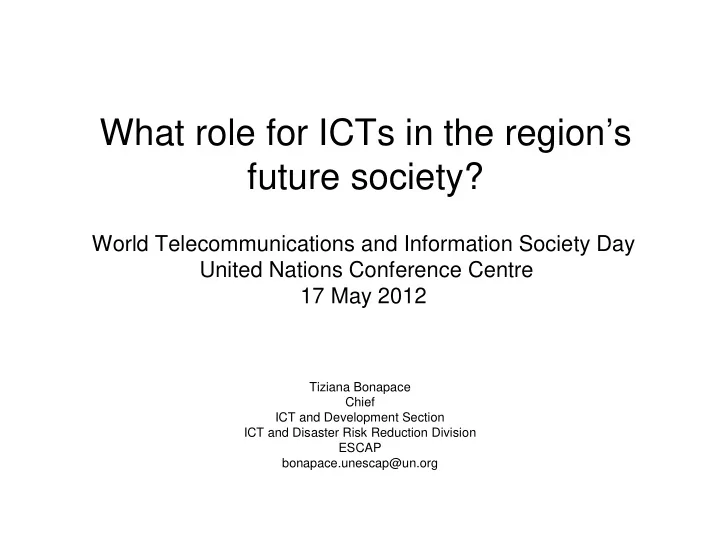

What role for ICTs in the region’s future society? World Telecommunications and Information Society Day United Nations Conference Centre 17 May 2012 Tiziana Bonapace Chief ICT and Development Section ICT and Disaster Risk Reduction Division ESCAP bonapace.unescap@un.org
Poverty • Rising prosperity: increase in real per capita GDP from US$ 1,795 to US$ 2,718 between 1990 and 2009 • Region still has 947 million people living in absolute poverty, of which about 20% are disabled (10% for general population) and 98% of disabled poor children do not attend school • Poor girls and women with disabilities experience triple discrimination
The region’s ageing society Growth in number of elder citizens, Asia (excl. W estern Asia) • Demographic 1.7 billion shifts will entail significant ageing 1.2 billion Ages +60 • Much older population, 400% 532 million Ages +65 increase in very old (+80) 357 million 288 million Ages +80 58 million 2010 2015 2020 2025 2030 2035 2040 2045 2050 Source : ESCAP, based on UNDESA population statistics, 2010 projections
….with increases all in developing countries Asian Advanced C ountries Growing old-age dependency ratios of 65+ age Asia P acific Developing C ountries excl. Asian categories in Asia billion Advanced C ountries 1.60 Central Asia 1.40 50 1.20 Eastern Asia 40 1.00 Oceania 30 0.80 South-Eastern Asia 0.60 20 0.40 Southern Asia 10 0.20 0.00 0 2011 2020 2030 2050 2100 2010 2015 2020 2025 2030 2035 2040 2045 2050 Source: United Nations, DESA, Population Division (2011). World Population Prospects: The 2010 Revision
… and feminization of the ageing society Female to male ratios in Asia, 60 years and over Female to male ratios in Asia, 80 years and over 2.6 2.6 Central Asia Central Asia 2.4 2.4 Female to male ratio Female to male ratio 2.2 2.2 Eastern Asia Eastern Asia 2.0 2.0 Oceania Oceania 1.8 1.8 South-Eastern Asia South-Eastern Asia 1.6 1.6 Southern Asia Southern Asia 1.4 1.4 Asia (excl. West 1.2 Asia (excl. West 1.2 Asia) Asia) 1.0 1.0 2010 2015 2020 2025 2030 2035 2040 2045 2050 2010 2015 2020 2025 2030 2035 2040 2045 2050 Source : ESCAP, based on UNDESA population statistics, 2010 projections
Future challenges • Non-communicable diseases (NCDs): increase with life expectancy worldwide, particularly in developing countries, from 20 to 70 million deaths per annum in Asia • Dementia projected to increase five fold • Pressure on public finances exacerbated by – lack of age-friendly, barrier-free environments – declining youth and working populations results in reduced capacity of families as primary caregivers – limited geriatric care services – lack of social protection coverage: 4.78% of GDP (Asia) as compared to 20.5% (OECD) • Mobility and autonomy losses • Isolation: – For example, proportion of elderly Indians living alone increased from 2.4% in 1992-95 to 5.0% in 2005-06 (from 2.6% to 7.6% among female population)
ICT for dignified ageing • Ambient Assisted-Living technologies (AAL), including remote monitoring, remote alarms – ICT make such system more economical, scalable but also customizable – improved feeling of security – address some potential hazards such as falls or illnesses by raising early alarms (e.g.: emerge system). Allow elderly to stay at home for longer, and / or mitigate severity of hazards by bringing early support, reducing hospitalization needs. • ICT for mental health – Facilitating and increasing the quality of monitoring and assistance of persons with Alzheimer Disease through innovative technologies integrated in patients’ domestic environments (e.g. Project Mantova – Alzheimer ) – Training cognitive capacities through games (e.g.: Eldergames), other electronic assisted stimuli, social networks • ICT for remote medicine – doc@HOME: remote consultations and prescriptions cuts the cost of health, allow elderly to stay at home longer – Applications related to chronic treatment of NCDs (e.g.: automated reminders for medicine) • ICT for social inclusion: – developing elderly friendly video-conferencing devices through TVs (e.g. i2home) – ICT literacy for elderly to use ICT tools such as VoiP, social media…
Recommendations • Current experience and knowledge addresses needs of developed countries where ageing is more advanced: adaption to local and developing contexts required. • Awareness building: ICT industry needs to prepare for demographic shifts, invest in R/D for aging – Design for All approaches: make technologies elderly friendly (including for illiterate elderly) – Respond growing demand for ICT applications for elderly • Develop research networks, including with other regions
Recommend
More recommend